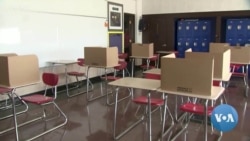Everyone agrees kids should be in school.
While opening schools in the fall has become the latest Trump administration political battle, the question is not whether it's a good idea. It's whether it can be done safely.
With the opening of the new school year just weeks away, President Donald Trump threatened school districts that do not send kids back to classrooms. Though the federal government has little control over school finances, he said in a tweet he "(m)ay cut off funding if not open!"
Teachers want it. Pediatricians want it.
“We recognize that children learn best when physically present in the classroom," the two largest U.S. teachers unions and the American Academy of Pediatrics said in a joint statement.
"(B)ut we must pursue reopening in a way that is safe for all students, teachers and staff," they add.
Public health experts say opening schools carries many of the same risks as opening businesses, and many communities that have done so too fast or without enough protections have seen coronavirus cases explode.
"In communities where the case numbers are rapidly increasing, it may not be possible to safely reopen schools until disease transmission is lower," said Jennifer Nuzzo, senior scholar at the Johns Hopkins Center for Health Security. "Can't stress that enough."
High stakes
Reopening schools is an important part of restarting the economy. Many parents working from home are struggling to do their jobs and care for their children at the same time. It's even harder for the millions of essential workers who can't work from home.
With the economy contracting and unemployment at levels not seen since the 1930s Great Depression, getting people back to work is a key political consideration ahead of November's election.
The stakes are high for students, too.
"Children get much more than academics at school," the pediatricians and teachers’ statement notes. Children also learn social and emotional skills at school. Nearly 30 million children rely on them for free or reduced-price meals each day. Millions more access mental health care there. Schools are the main sources of reporting for child and sexual abuse.
COVID-19 tends to be less serious for children than for adults. Studies have found they are less likely to get infected, suffer severe illness and die from the disease. Children also don't seem to spread the illness as much, but the evidence is limited.
However, "while the risk is lower, less risk does not mean no risk," said Josh Sharfstein who is vice dean of the Johns Hopkins Bloomberg School of Public Health.
More than 200,000 coronavirus infections among children in the U.S. have been reported as of July 9, according to the AAP, including 63 deaths.
And teachers and staff are at risk, just like people at any other indoor workplace.
If Trump demands that schools open despite the risks, "then I want Donald Trump to sit in the back of my class of 39 and breathe their air," said Lily Eskelsen García, president of the National Education Association, the nation's largest teachers union. "I want him to sit there for seven hours, five days a week and have those kids cough and sneeze on him."
Johns Hopkins researchers estimate it will cost $50 billion to prepare U.S. schools to welcome students safely.
International openings
Other countries have opened schools without setting off new outbreaks.
In South Korea, elementary, middle and special education schools can only have one third of their students in class at a time, while high schools are limited to two-thirds of classroom capacity. When students are not in class, they have remote instruction.
In Germany, older students went back to school first. Officials considered them better able to comply with social distancing measures.
Belgian primary school children stay in their classes or "bubbles" throughout the day to minimize contact with other classes.
Many countries require students, teachers and staff to wear masks. Some countries stagger arrival, departure and lunch times to minimize crowds. Plastic dividers separate students from each other in many places. Hand sanitizer is made widely available.
One key factor that separates them from the United States, however, is that "each of these countries started from having their epidemics under control," Nuzzo at Johns Hopkins said.
Israel presents a cautionary tale, she noted. The country lifted restrictions while infections were on the rise, leading to outbreaks that closed schools.









